How Much Does One Cannabis Seed Yield?
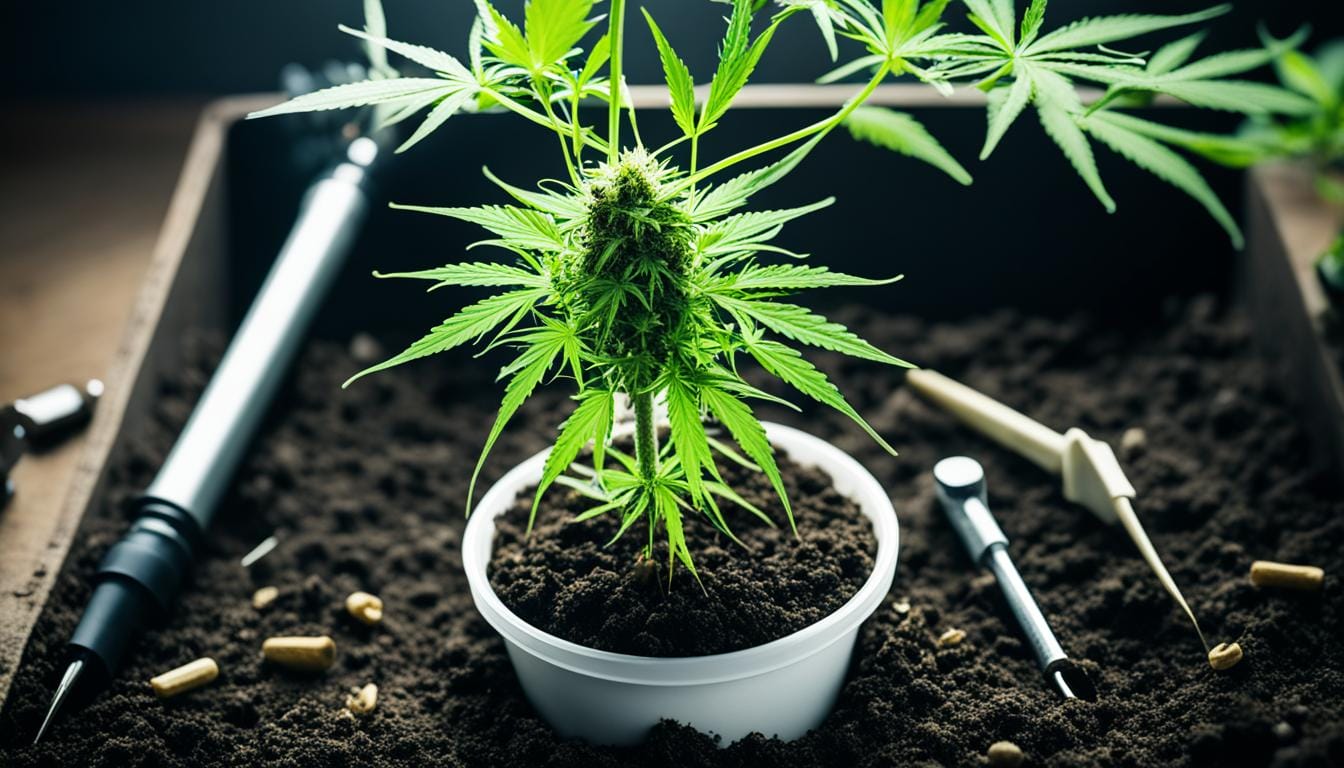
Every person growing cannabis, whether they’re starting out or have years of experience, faces an important question: What yield can you expect from one cannabis seed? This might seem straightforward, but it’s not. Growing cannabis involves combining genetics, the right care, and specific environmental conditions. These factors together decide how much you can actually get from your plants. Whether you grow cannabis for business or as a hobby, knowing about these aspects is crucial for success.
Growing cannabis isn’t just about how many plants you have. It’s about understanding the potential of each seed and how you can make the most out of it. From when you plant the seed until you harvest, every choice affects whether your yield will be big or small. This guide aims to show you how to use each seed’s potential to the fullest. Our goal is to help you achieve the best harvest possible.
Key Takeaways
- Understanding yield potential is crucial for setting realistic cannabis cultivation goals.
- Several factors, including genetics and growing conditions, influence the output of cannabis seeds.
- Optimal care and cultivation techniques can significantly boost harvest totals.
- Exploring the role of genetics and environment paves the way for maximum yield.
- Insights from this article empower growers to make informed decisions in their cultivation practices.
Understanding the Yield Potential of Cannabis Seeds
The idea of yield potential is key in cannabis cultivation. It helps growers know what they might achieve under the best conditions. It shows how much they can get from their time, effort, and resources.
But, many factors influencing yield come into play. These range from the seed’s genetics to how it’s grown. To really tap into cannabis seeds’ yield potential, you have to look at lots of things. Each one has its own hurdles and chances.
Knowing that yield potential can change helps growers set good goals. They can then improve their methods. To get the most yield, they consider many things, such as:
- The seed’s genetic makeup and what it can do
- The light, humidity, and temperature of the environment
- How to manage nutrients and soil quality
- Using both old and new ways to grow better
Growers learn from the mix of these factors. They work step by step to get closer to the top yield of cannabis seeds. The goal of yield potential moves as they learn more. They master the mix of art and science in cannabis cultivation.
Factors Influencing Cannabis Seed Yield
When trying to boost their cannabis crops, growers must look at several factors influencing yield. These aspects work together, helping or hindering plant output. Important areas include the genetics of the plant and the growing conditions it’s in. Using techniques like plant training and pruning is also key to getting more. Let’s explore how each factor plays a part in successful cannabis growing.
The Role of Genetics in Yield Outcomes
Genetics are the core of what a cannabis plant can ultimately produce. The seed’s genetic code shows its highest yield possibilities. Growers can pick seeds that are known to produce more. But for these seeds to reach their full potential, they need the right conditions.
Importance of Optimal Growing Conditions
The right growing conditions are critical. This includes the light, temperature, humidity, and nutrition the plant gets. Good management of these areas can really boost your yield. The right light lets plants do photosynthesis well. The best temperature and humidity keep plants strong. And the right food is like the plant’s lifeblood, fueling its growth and bud production.
The Impact of Plant Training and Pruning Techniques
Shaping cannabis plants through plant training helps them get more light and grow more buds. Low-stress training (LST), super cropping, and the Screen of Green (ScrOG) are some ways to do this. Pruning techniques are also important. They let growers cut away unneeded leaves and branches. This helps the plant focus on growing bigger flowers.
All these factors come together to maximize the yield from cannabis seeds. Understanding and applying these principles can make a big difference. It leads to bigger harvests that meet both personal and commercial goals.
Indoor vs. Outdoor Growing: Yield Comparisons
Choosing between indoor growing and outdoor growing is important in cannabis cultivation. Each method has its own set of benefits and challenges. These affect how much can be grown and the strategies used. Knowing the differences helps growers pick the best method for their goals and situation.
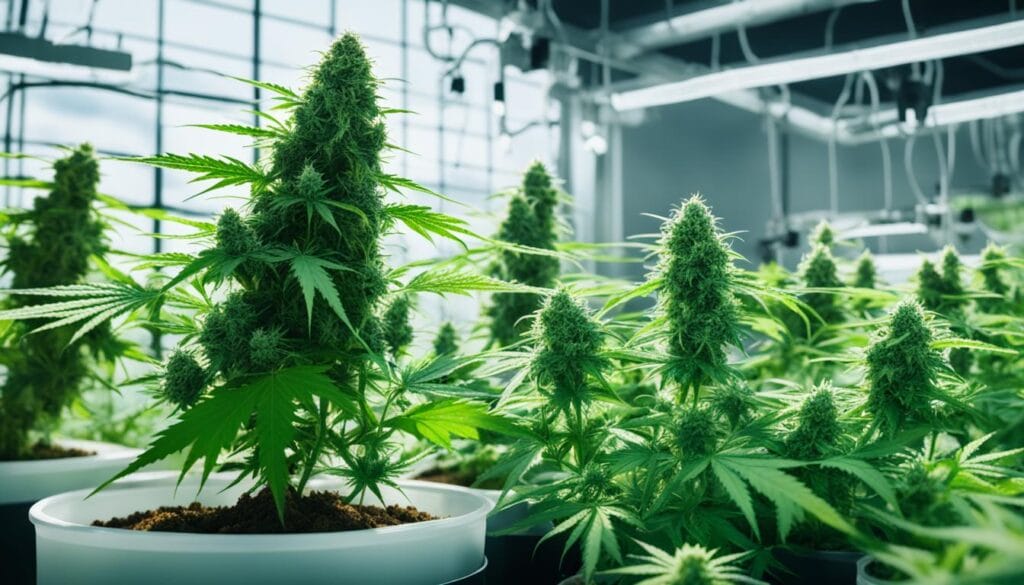
With indoor growing, growers can control every part of the environment. They adjust temperature, humidity, light, and CO2 levels. This helps plants grow well. On the other hand, growing outside means the weather and soil have a big impact. The sun and climate are key factors in how the plants grow.
Many growers love outdoor growing for being eco-friendly and producing natural products. But, they know the weather can change how much they grow.
The table below shows how indoor and outdoor growing compare. It looks at how much can be grown and other important factors:
| Aspect | Indoor Growing | Outdoor Growing |
|---|---|---|
| Yield Potential | Consistent and high due to controlled conditions | Dependent on environmental factors and seasonality |
| Quality Control | Premium quality with controlled inputs | Natural quality, can be variable due to pests and weather |
| Visibility of Grow | Private and discrete | Potentially visible, subject to security concerns |
| Energy Consumption | Can be high due to artificial lighting and climate control | Energy from the sun, sustainable |
| Start-Up Costs | Generally higher due to equipment | Lower, relying on natural elements |
Indoor growing usually means more crops per year, leading to higher yields per square foot. In contrast, outdoor growing can give bigger plants because they grow longer in the sun. Growers must think about these differences when deciding how to grow their cannabis.
Maximizing Yield: Expert Techniques for Cannabis Cultivation
Successful cannabis growing depends on focusing on key elements that lead to maximizing yield. By applying expert techniques in areas like nutrients, light, and water, growers can upgrade their methods. This ensures healthy plants and big harvests. Let’s look into the best strategies for nutrient control, managing light, and setting watering times to get a bumper cannabis crop.
Nutrient Management for Healthy Cannabis Plants
Nutrient management is crucial for thriving cannabis plants. Plants need nutrients like nitrogen, phosphorus, and potassium, plus many micronutrients, for good growth. It’s key to adjust the mix of nutrients as the plant grows. For the growing phase, more nitrogen is needed; for flowering, more phosphorus and potassium is important. A smart tip: slowly reduce nutrients as harvest time comes to stop nutrient block and boost taste.
Strategies for Light Optimization
Light optimization involves balancing light’s power, time, and kind, which is vital for growing cannabis. Proper light helps with photosynthesis and moves the plant through growth stages. Many top growers use LEDs that mimic sunlight to help plants grow best. They keep lights on for 18 hours a day for growing, then 12 hours for flowering to help start bud-making. Here’s a tip: add ultraviolet light late in the process to increase trichome production and improve the cannabis’s strength and taste.
Implementing a Proper Watering Schedule
Setting the right watering schedule also deeply affects how much you harvest. Giving plants too much or too little water can cause problems. Top growers let the soil dry a bit before watering again. This helps roots grow strong and take up nutrients well. Using a moisture meter makes sure you water just right, keeping plants healthy and productive.
Common Yield Metrics for Cannabis Seeds
Growers starting with cannabis cultivation want to know the yield metrics. These help predict harvest outcomes. These common measurements are key in understanding the potential yields of cannabis seeds. They act as guides for evaluating different strains’ productivity. So, these numbers tell growers what they might harvest from their efforts.
Let’s explain yield metrics more simply. Here are some measurements used in the field:
- Grams per Square Meter (g/m²): This tells us how much dried flower we get from a certain area.
- Ounces per Plant (oz/plant): This shows the weight of usable product from one plant.
- Percentage of THC/CBD: This doesn’t measure volume but is crucial for judging the yield’s potency and quality.
Knowing these yield metrics helps growers plan better. They can choose to grow lots of plants close together or a few plants with more care. These common measurements guide them toward successful harvesting. By keeping track of these numbers from when the cannabis seeds start growing to when the flowers bloom, growers can improve and predict their yields.
The Role of Plant Count Per Light in Determining Yield
In cannabis cultivation, it’s crucial to focus on yield determination and the strategies behind it. The plant count per light greatly influences how much you can harvest. Choosing the right number of plants under each light is a vital decision for growers.
Benefits of a Lower Plant Count
Having fewer plant counts per light can improve both yield quality and plant health. This reduction lessens the fight for light, nutrients, and space, letting each plant thrive. More space also boosts air flow, reducing mold and pests, resulting in stronger plants.
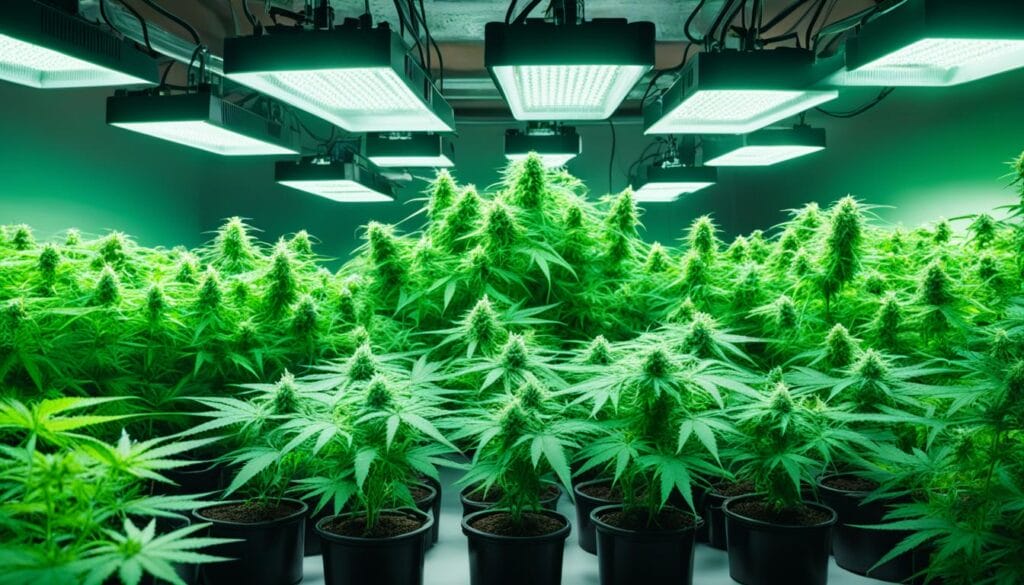
Maximizing Individual Plant Yields
There are specific ways to maximize individual plant yields. These methods put the spotlight on enhancing each plant’s potential. Balanced growth through these techniques often leads to better yields.
| Technique | Description | Benefits |
|---|---|---|
| Low-Stress Training (LST) | Gently bending and tying plants to control their shape and height. | Promotes even light distribution and potentially increases bud sites. |
| Sea of Green (SOG) | Growing many small plants to maturity quickly in a limited space. | Reduces vegetation time and can lead to more frequent harvests. |
| Screen of Green (SCROG) | A screen is used to spread out plant branches, optimizing light penetration to lower branches. | Leads to higher yields from each plant and efficient use of space. |
| Pruning | Removing lower growth that receives less light to focus the plant’s energy on top buds. | Can improve air flow and direct energy to parts of the plant that will produce higher-quality buds. |
Choosing between high or low plant count per light depends on many factors. Successful cannabis cultivation mixes the science of growing with the art of getting the most from each plant. Tailoring these approaches to fit your space and goals is key.
Cannabis seeds: In Search of High-Quality Strains for Maximum Yield
Finding the best cannabis seeds can change everything for growers. High-quality strains have the right genes for big, healthy harvests. These seeds lead the way in growing cannabis. They promise a lot of yield and excellent quality.
How Premium Genetics Can Influence Your Harvest
The saying “genetics is king” is very true in the cannabis world. Premium genetics mean the plant can grow well and produce a lot of flowers. Growers who choose high-quality strains from trusted sources see big benefits. This includes organic cannabis seeds. They are grown naturally, without harmful chemicals. So, they have strong and clean genetics.
Selecting the Right Cannabis Seeds Online
Nowadays, buying top-quality cannabis seeds online is easier. But, with so many choices, it can be hard to decide. Look at the strain reviews, who bred them, and their genetic history. Whether you want the energy from sativa or the calm from indica, choosing wisely is key. It’s the first step to getting a lot of yield.
The Significance of Organic and Autoflower Seeds
Autoflower cannabis seeds have changed how we grow cannabis. They grow fast and don’t need special lights. These seeds are tough and good for quick yields. Also, organic cannabis seeds show people want to grow plants in a healthy way. They lead to a clean and strong harvest.
Choosing the right seeds is vital for a good yield. Knowing about premium genetics and organic and autoflower cannabis seeds helps a lot. It’s important to focus on these things. That way, growers can improve their skills and enjoy their work. The result? Lots of high-quality cannabis.
| Seed Type | Genetic Makeup | Yield Potential | Grow Cycle | Suitability for Beginners |
|---|---|---|---|---|
| Regular Seeds | Varied | Dependent on Strain | Requires light cycle management | Moderate |
| Organic Seeds | Natural, No synthetic intervention | High, Pure Quality | Requires light cycle management | Good, with Organic Practices |
| Autoflower Seeds | Ruderalis crossbreeds | Fast, Can be smaller yields | No light cycle management needed | Excellent |
Anticipating Yield from Autoflower vs. Photoperiod Cannabis Seeds
The choice between autoflower and photoperiod cannabis seeds matters a lot. Each type offers different yields and grows in unique ways. Knowing these differences helps growers plan better and get the most out of their crops.
Understanding the Growth Cycle of Autoflower Seeds
Autoflower cannabis seeds are tough and quick. They grow no matter the light changes. They move from the vegetative stage to flowering on their own. This process takes about 8 to 10 weeks. This quick growth lets growers have more than one harvest in a season.
Yield Differences: Autoflower vs. Photoperiod
Autoflower and photoperiod seeds respond differently to light. Photoperiod strains need light changes to start flowering. This lets growers decide how long plants stay in the vegetative stage. Because of this, photoperiod plants can yield more.
Photoperiod strains grow bigger, which might mean more yield. But, autoflowers are simpler and faster to grow. This is great for places with short growing seasons.
| Seed Type | Growth Cycle Duration | Yield Potential |
|---|---|---|
| Autoflower Cannabis Seeds | 8-10 weeks | Generally smaller per plant |
| Photoperiod Cannabis Seeds | Varies based on light exposure | Generally larger per plant |
It’s important to understand these yield differences. Knowing this helps set the right expectations for your cannabis grow. You can choose autoflowers for simplicity or photoperiod seeds for more yield.
Conclusion
In the world of cannabis cultivation, growers aim to understand and increase yield potential. We’ve explored the key elements that affect harvest size from each cannabis seed. We’ve looked at the importance of genetics, ideal growing conditions, and expert growing methods. Growing cannabis blends science and art, with each part crucial to the final yield.
The factors affecting yield are many. By using best practices, growers can boost their harvests. Quality cannabis seeds are essential. Also, knowing how to care for those seeds can greatly improve yield potential. The way growers manage plant count per light shows their skill and dedication to high yields.
To wrap up, achieving high yields comes from smart seed choice and good growing strategies. Whether you want strong, dense buds or lots of flowers, every decision from planting to harvest affects your yield. With these insights, growers can plant their cannabis seeds with more confidence and look forward to a fruitful harvest.
FAQ
What yield can you expect from one cannabis seed?
The yield from a cannabis seed varies a lot. It depends on its genetics, how it’s grown, and the care it gets. Yields can greatly change under different conditions.
What is the role of genetics in determining yield outcomes for cannabis seeds?
Genetics are key in figuring out how much a cannabis seed will produce. Different strains offer different yields. That’s why picking seeds with good genetics is vital for getting a lot of produce.
How do growing conditions impact the yield of cannabis seeds?
The yield depends much on growing conditions like light, temperature, and soil nutrients. The right conditions boost growth and yield. Making sure plants get what they need is crucial.
What is the significance of plant training and pruning techniques in maximizing yield?
Training and pruning your plants right can really help increase yield. These methods improve light reach and encourage more buds to form. It’s a smart way to get more from your cannabis seeds.
What are the differences between indoor and outdoor growing in terms of yield outcomes for cannabis seeds?
Yields can differ a lot between indoor and outdoor grows. Knowing these differences can guide growers on the better method for them. Each method suits different grower needs and yield goals.
What expert techniques can be used to maximize the yield of cannabis plants?
For bigger yields, growers can control nutrients, light, and water well. These expert moves help plants grow strong and fruitful. Healthy plants means more yield.
What are the common yield metrics used for measuring the yield of cannabis seeds?
Yield metrics are key for knowing a plant’s potential. They help compare different strains. Understanding these metrics lets growers pick the best strains.
How does the number of plants per light impact yield outcomes in cannabis cultivation?
Plant count per light affects yields greatly. More plants might mean more yield, but fewer plants could mean bigger yields per plant. It’s all about finding the right balance for your setup.
How do genetics influence the harvest, and how can I select the right cannabis seeds online?
Picking strains with strong genetics is crucial for good yields. When shopping for seeds online, look for strains with proven genetics. Choose from trusted sources that offer a variety of strains.
What are the differences between autoflower seeds and photoperiod seeds in terms of yield outcomes?
Autoflower and photoperiod seeds grow differently and produce different yields. Knowing about their growth and yield can help plan better. This understanding is key for setting yield goals.
Suggested Articles
;)
;)
;)



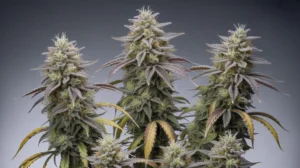
 18 Dec 2025
18 Dec 2025  5 min read
5 min read
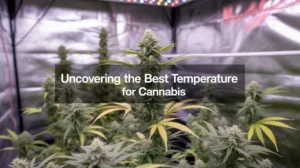

 May 13, 2024
May 13, 2024 


RESPONSES (0)
No responses yet. Be the first to respond!